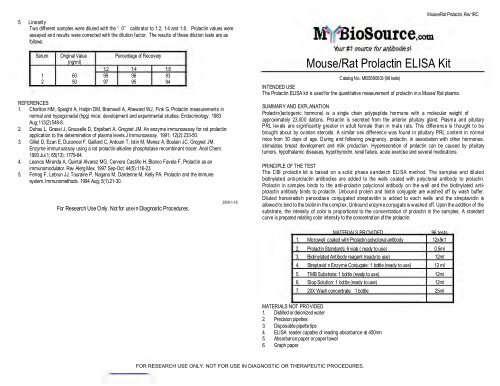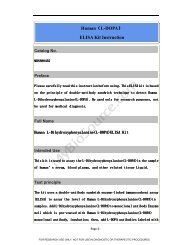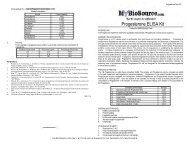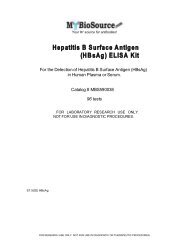Mouse/Rat Prolactin ELISA Kit - MyBioSource
Mouse/Rat Prolactin ELISA Kit - MyBioSource
Mouse/Rat Prolactin ELISA Kit - MyBioSource
You also want an ePaper? Increase the reach of your titles
YUMPU automatically turns print PDFs into web optimized ePapers that Google loves.
5. Linearity<br />
Two different samples were diluted with the 0 calibrator to 1:2, 1:4 and 1:8. <strong>Prolactin</strong> values were<br />
assayed and results were corrected with the dilution factor. The results of these dilution tests are as<br />
follows:<br />
Serum Original Value Percentage of Recovery<br />
(ng/ml)<br />
1:2 1:4 1:8<br />
1 60 99 96 93<br />
2 50 97 95 94<br />
REFERENCES<br />
1. Charlton HM, Speight A, Halpin DM, Bramwell A, Aheward WJ, Fink G. <strong>Prolactin</strong> measurements in<br />
normal and hypogonadal (hpg) mice: development and experimental studies. Endocrinology. 1983<br />
Aug;113(2):548-8.<br />
2. Duhau L, Grassi J, Grouselle D, Enjalbert A, Grognet JM. An enzyme immunoassay for rat prolactin:<br />
application to the determination of plasma levels.J Immunoassay. 1991; 12(2):233-50.<br />
3. Gillet D, Ezan E, Ducancel F, Gaillard C, Ardouin T, Istin M, Menez A, Boulain JC, Grognet JM.<br />
Enzyme immunoassay using a rat prolactin-alkaline phosphatase recombinant tracer. Anal Chem.<br />
1993 Jul 1; 65(13): 1779-84.<br />
4. Leanos Miranda A, Quintal Alvarez MG, Cervera Castillo H, Blanco Favela F. <strong>Prolactin</strong> as an<br />
immunomodulator. Rev Alerg Mex. 1997 Sep-Oct; 44(5):116-23.<br />
5. Ferrag F, Lebrun JJ, Touraine P, Nagano M, Dardenne M, Kelly PA. <strong>Prolactin</strong> and the immune<br />
system. Immunomethods. 1994 Aug; 5(1):21-30.<br />
For Research Use Only. Not for use in Diagnostic Procedures.<br />
2009-1-18<br />
<strong>Mouse</strong>/<strong>Rat</strong> <strong>Prolactin</strong> <strong>ELISA</strong> <strong>Kit</strong><br />
Catalog No.: MBS580033 (96 tests)<br />
<strong>Mouse</strong>/<strong>Rat</strong> <strong>Prolactin</strong>, Rev1RC<br />
INTENDED USE<br />
The <strong>Prolactin</strong> <strong>ELISA</strong> kit is used for the quantitative measurement of prolactin in a <strong>Mouse</strong>/ <strong>Rat</strong> plasma.<br />
SUMMARY AND EXPLANATION<br />
<strong>Prolactin</strong> (lactogenic hormone) is a single chain polypeptide hormone with a molecular weight of<br />
approximately 23,000 daltons. <strong>Prolactin</strong> is secreted from the anterior pituitary gland. Plasma and pituitary<br />
PRL levels are significantly great er in adult female than in male rats. This differenc e is t hought t o be<br />
brought about by ov arian steroids. A similar s ex difference was found in pituitary PRL c ontent in normal<br />
mice from 30 days of age. During and following pregnancy, prolactin, in association with other hormones,<br />
stimulates breast development and milk production. Hypersecretion of prolactin can be caused by pituitary<br />
tumors, hypothalamic diseases, hypothyroidm, renal failure, acute exercise and several medications.<br />
PRINCIPLE OF THE TEST<br />
The CBI prolactin kit is based on a solid phas e sandwich ELI SA met hod. The samples and diluted<br />
biotinylated anti-prolactin antibodies are added to the wells coated with polyclonal antibody to prolactin.<br />
<strong>Prolactin</strong> in samples binds to the anti-prolactin polyclonal antibody on the well and the biotinylated antiprolactin<br />
antibody binds to prolactin. Unbound protein and biotin conjugate are washed off by wash buffer.<br />
Diluted horseradish peroxidase conjugated strept avidin is added to each wells and the streptavidin is<br />
allowed to bind to the biotin in the complex. Unbound enzyme conjugate is washed off. Upon the addition of the<br />
substrat e, the intensity of color is proportional to the concentration of prolactin in the samples. A standard<br />
curve is prepared relating color intensity to the concentration of the prolactin.<br />
MATERIALS PROVIDED<br />
96 tests<br />
1. Microwell coated with <strong>Prolactin</strong> polyclonal antibody 12x8x1<br />
2. <strong>Prolactin</strong> Standards: 6 vials ( ready to use) 0.5ml<br />
3. Biotinylated Antibody reagent (ready to use) 12ml<br />
4. Streptavid n Enzyme Conjugate: 1 bottle (ready to use) 12 ml<br />
5. TMB Substrate: 1 bottle (ready to use) 12ml<br />
6. Stop Solution: 1 bottle (ready to use) 12ml<br />
7. 20X Wash concentrate: 1 bottle 25ml<br />
MATERIALS NOT PROVIDED<br />
1. Distilled or deionized water<br />
2. Precision pipettes<br />
3. Disposable pipette tips<br />
4. <strong>ELISA</strong> reader capable of reading absorbance at 450nm<br />
5. Absorbance paper or paper towel<br />
6. Graph paper<br />
FOR RESEARCH USE ONLY. NOT FOR USE IN DIAGNOSTIC OR THERAPEUTIC PROCEDURES.
STORAGE AND STABILITY<br />
1. Store the kit at 2 - 8° C.<br />
2. Keep microwells sealed in a dry bag with desiccants.<br />
3. The reagents are stable until expiration of the kit.<br />
WARNINGS AND PRECAUTIONS<br />
1. Do not pipette by mouth. Do not smoke, eat, or drink in the areas in which specimens or kit reagents<br />
are handled.<br />
2. The components in this kit are intended for use as an integral unit. The components of different lots<br />
should not be mixed.<br />
3. It is recommended that standards, control and serum samples be run in duplicate.<br />
4. Optimal results will be obtained by strict adherence to this protocol. Accurate and precise pipetting,<br />
as well as following the exact time and temperat ure requirements prescribed are essential. Any<br />
deviation from this may yield invalid data.<br />
SPECIMEN COLLECTION HANDLING<br />
1. Collect blood specimens and separate the plasma immediately.<br />
2. Specimens may be stored refrigerated at (2-8° C) for 5 days. If storage time exceeds 5 days, store<br />
frozen at (-20° C) for up to one month.<br />
3. Avoid multiple freeze-thaw cycles.<br />
4. Prior to assay, frozen sera should be completely thawed and mixed well.<br />
REAGENTS PREPARATION<br />
Prepare 1X Wash buffer by adding the contents of the bottle (25 ml, 20X) to 475 ml of distilled or deionized water.<br />
Store at room temperature (18-26° C).<br />
ASSAY PROCEDURE<br />
Prior to assay, allow reagents to stand at room temperature.<br />
Gently mix all reagents before use.<br />
1. Place the desired number of coated strips into the holder<br />
Example of a standard curve<br />
Standard Conc.(ng/ml) OD (450 nm)<br />
1 0 0.07<br />
2 3 0.19<br />
3 6 0.36<br />
4 25 0.79<br />
5 100 1.45<br />
6 200 2.01<br />
<strong>Mouse</strong>/<strong>Rat</strong> <strong>Prolactin</strong>, Rev1RC<br />
LIMITATIONS OF THE Test<br />
1. The test results obtained using this kit is for research use. It is recommended that each lab establish<br />
normal range based on sample population.<br />
2. Do not use sodium azide as preservative. Sodium azide inhibits HRP enzyme activities.<br />
PERFORMANCE CHARACTERISTICS<br />
1. Precision<br />
Intra-Assay<br />
Serum<br />
1<br />
2<br />
3<br />
Inter-assay<br />
No. of Mean Standard Coefficient of<br />
Replicates ng/ml Deviation Variation (%)<br />
16 30.1 2.1 6.9<br />
16 16.2 0.8 4.9<br />
16 5.1 0.3 5.9<br />
No. of Mean Standard Coefficient of<br />
Serum<br />
Replicates ng/ml Deviation Variation (%)<br />
2. Pipet 50 ml of <strong>Prolactin</strong> standards, control and patient’s sera. 1 10 32.2 2.1 6.5<br />
3. Add 100 ml of biotin conjugate to all wells. Shake the plate for 10 seconds to mix the solution. 2 10 16.7 0.88 5.3<br />
4. Cover the plate and incubate for 60 minutes at room temperature (18-26° C). 3 10 5.2 0.4 7.7<br />
5. Remove liquid from all wells. Wash wells three times wit h 300 ml of 1X wash buffer. Blot on<br />
absorbance paper or paper towel.<br />
6. Add 100 ml of streptavidin enzyme conjugate to all wells.<br />
7. Cover the plate and incubate for 30 minutes at room temperature.<br />
8. Remove liquid from all wells. Wash wells three times wit h 300 ml of 1X wash buffer. Blot on<br />
absorbance paper or paper towel.<br />
2. Sensitivity<br />
The sensitivity was determined by calculating the mean plus 2SD of the standard zero point tested 20<br />
times in the same run.<br />
No. of Mean Standard Mean + 2SD<br />
Serum<br />
9. Add 100µ l of TMB substrate to all wells Replicates ng/ml Deviation (Sensitivity)<br />
10. Cover plate and incubate for 15 minutes at room temperature. Zero Standard 20 0.10 0.05 0.2 ng/ml<br />
11. Add 50 ml of stop solution to all wells.<br />
12. Read absorbance on <strong>ELISA</strong> Reader at 450 nm within 15 minutes after adding the stopping solution.<br />
CALCULATION OF RESULTS<br />
The standard curve is constructed as follows:<br />
1. Check prolactin standard values on each standard vial. This value might vary from lot to lot. Make<br />
sure you check the value on every kit. See example of the standard attached.<br />
2. To construct the standard c urve, plot the absorbance for the standards (vertic al axis) versus the<br />
standard concentrations (horizontal axis) on a linear graph paper. Draw the best curve through the<br />
points.<br />
3. Read the absorbance for controls and each unknown sample from the curve. Record the value for<br />
each control or unknown sample.<br />
FOR RESEARCH USE ONLY. NOT FOR USE IN DIAGNOSTIC OR THERAPEUTIC PROCEDURES.<br />
3. Recovery<br />
Known quantities of prolactin were added to a serum that contained a low concentration of <strong>Prolactin</strong>.<br />
Expected Value(ng/ml) Recovered (ng/ml) Percentage of Recovery<br />
5 4.6 92<br />
20 19.6 98<br />
40 42 105






![Intact-PTH [Parathyroid Hormone] ELISA [Enzyme ... - IBL-America](https://img.yumpu.com/38260466/1/184x260/intact-pth-parathyroid-hormone-elisa-enzyme-ibl-america.jpg?quality=85)





